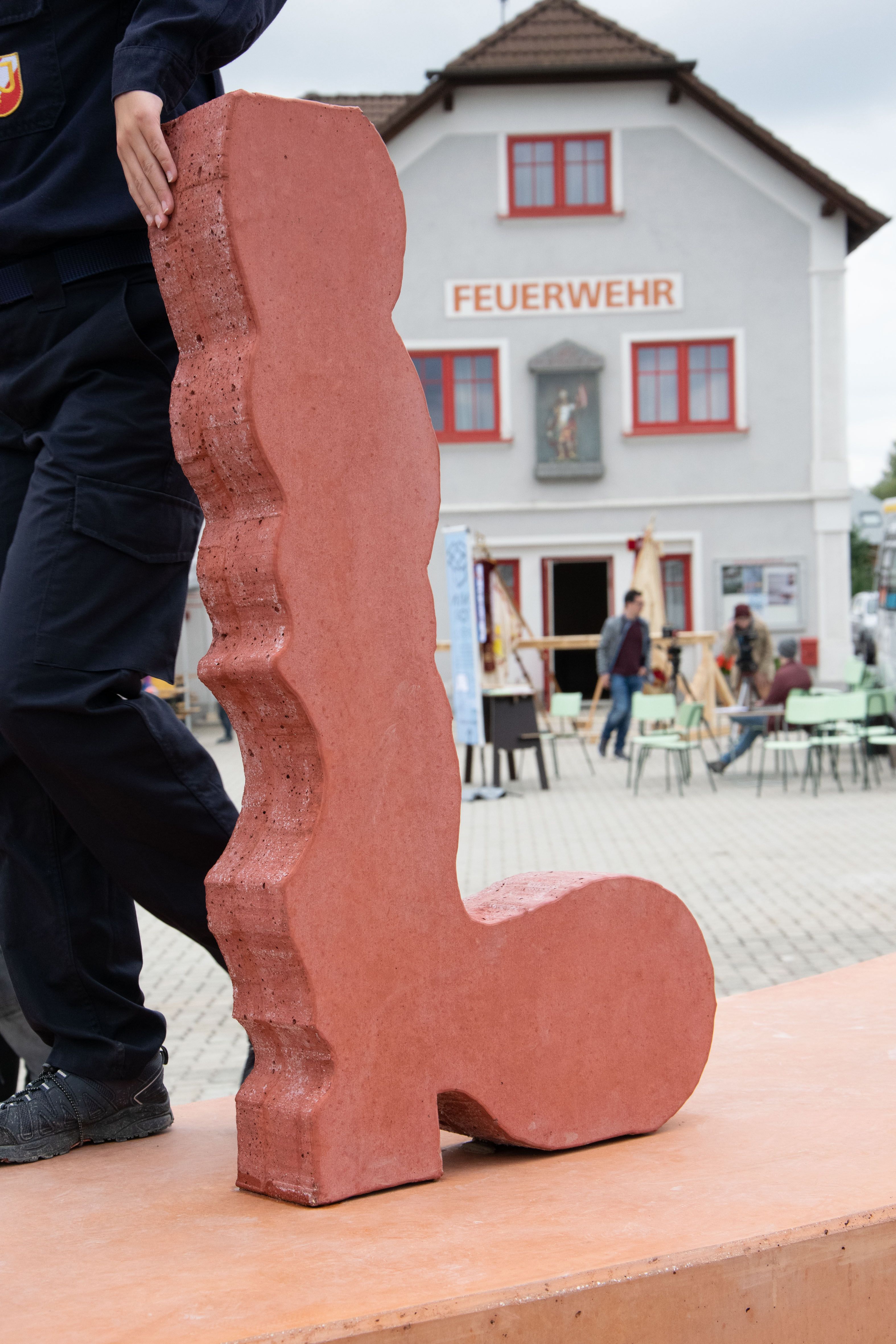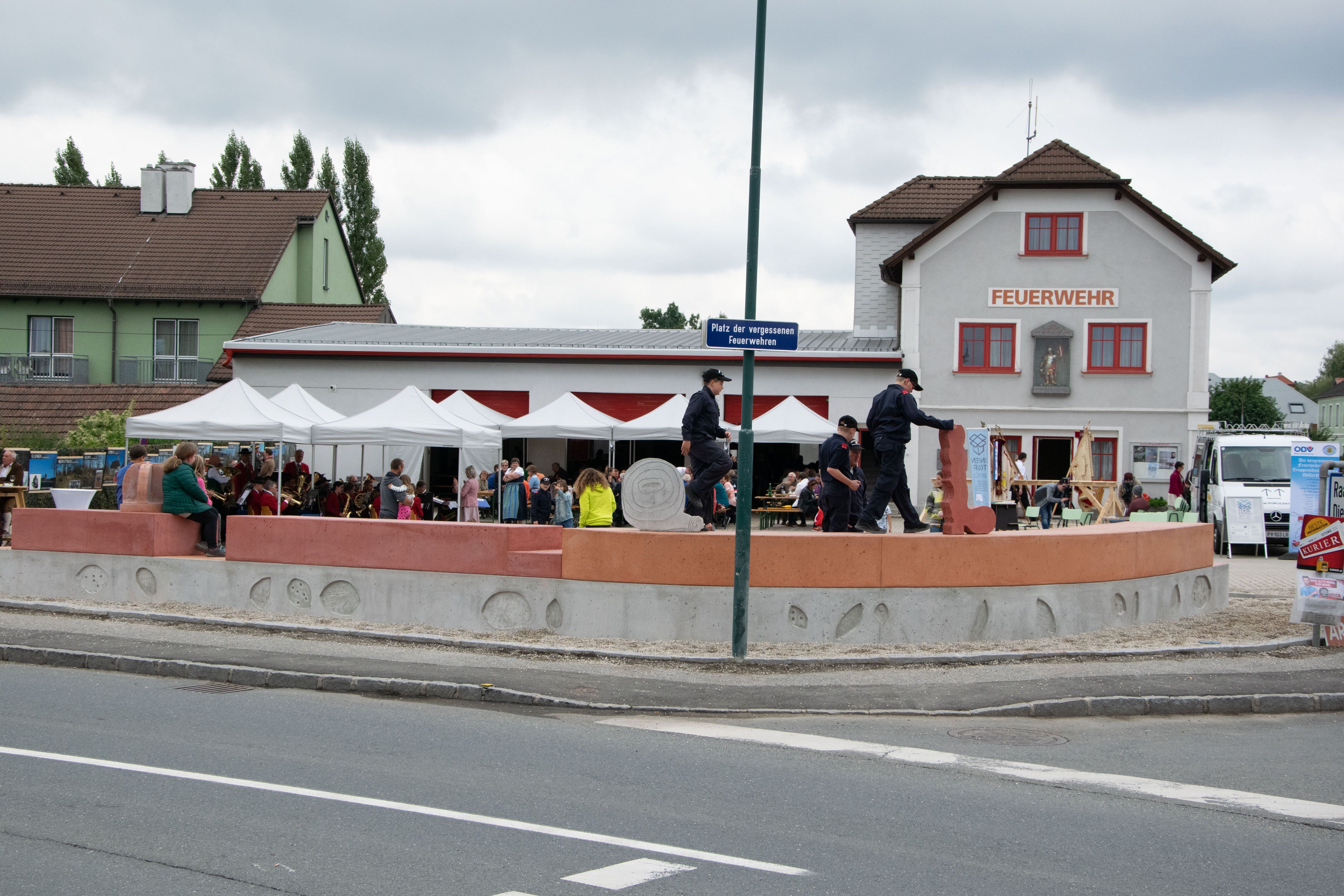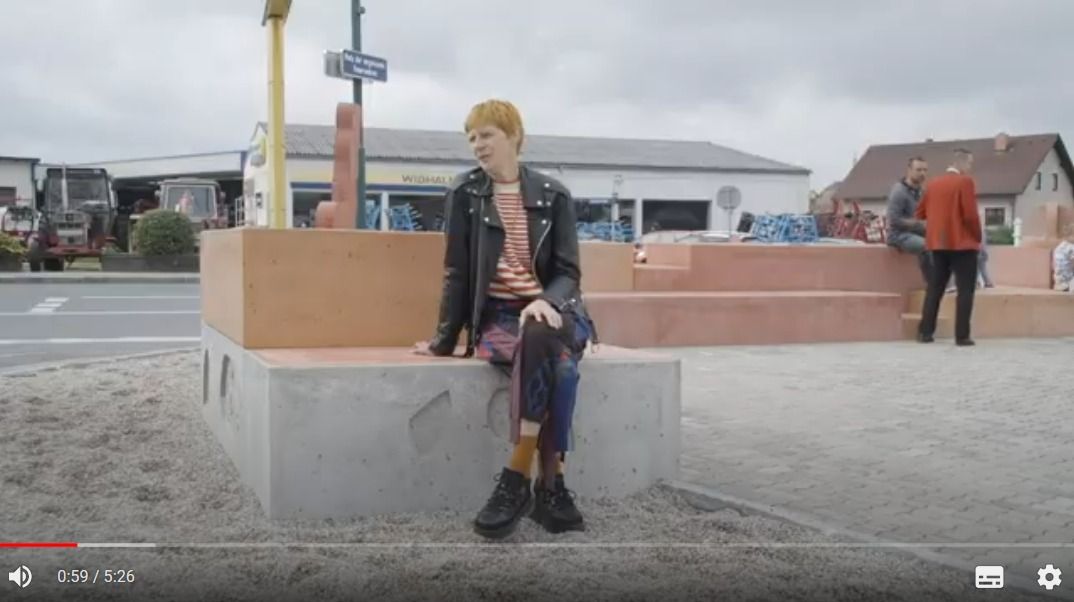Maruša Sagadin
:
Treppe-Bühne-Tribüne. Der Liegende Abdruck.
Back
Information
The public square in front of the volunteer fire department station in Göpfritz an der Wild is large and spacious—a kind of placeholder for village festivals and putting up maypoles or Christmas trees that can be seen from far away. It is located at an intersection that is virtually on the outskirts of town, where drivers can sense that the city limits are close and press harder on the gas pedal, yet still central enough that there is a sidewalk.
Since the fall of 2019, an architectural and sculptural element made of concrete now has been running parallel to the curve of the road around the square. It consists of a base in which there are a few gaps on the street side, while on the other side it forms a staircase toward the square. We would rather expect this infrastructural stair-like gesture to be on a public square in a more urban environment, but here it defines the new village square. It also acts as the spatial counterpart to the statelier fire station. Staircase – Stage – Platform. The Lying Imprint is the title of this monument by the artist Maruša Sagadin from Vienna. In place of a vertical monument that can be seen from afar—an exclamation point in the landscape—it is rather a monument “lying” on its side. At home in the present, it also promotes an active culture of remembrance.
The monument commemorates the 16 volunteer fire departments that were dissolved when 42 villages were “resettled” by the Nazis between 1938 and 1942. In order to establish the Allentsteig military training grounds, inhabitants were forced to leave the area, which is still a restricted military zone today. With this resettlement to different towns and areas, the social structures and clubs in these villages were also lost, along with them the social cohesion established by the volunteer fire departments. Over time, they were forgotten, until the work of Gerhard Schneider, who is in charge of researching the history of the fire departments in the Allentsteig military training area, inspired the wish for a site to commemorate these fire departments in Göpfritz an der Wild. At the time, the Department of Public Art Lower Austria issued an invitational call to artists, and Maruša Sagadin was able to realize an artistic translation.
Orange and red concrete elements are placed on top of each other, like stairs. They are broken up or interrupted by gaps that make it easier to climb on them. On the top level are three abstracted, over-sized objects that refer to fire departments: a helmet, a hose rolled up, and a boot. On the street side at ground level, a ledge of exposed concrete runs along the entire length of the object, forming a kind of relief that is adorned with imprints of organic materials, like branches, pebbles, pine cones, and hay. These materials symbolize some of the types of emergencies for which fire departments are deployed: like fires, mudflows, explosions, and flooding. The imprints can also be read as symbols of nature that has been left to grow wild, like in the military training zone, where it is slowly grow over all human traces with its astonishing lushness. The contrast between the hard concrete with its warm colors and the nature reliefs seems to refer to the contradictions of the assumed military order in the military training area on the one hand, and the wildness and power of nature reconquering its environment on the other. This is an unsolvable dilemma—like how those people who were resettled lost their land and their homes, while parts of this same land now form a unique natural refuge.
The monument not only lends form to the memory of the forgotten fire departments; it also stands for the significance of Göpfritz’s own volunteer fire departments for its social and cultural life. In addition, it provides a space for remembering the resettlement of so many people as a historical event. The initiators of the monument wanted to ensure that this history would not be lost, that people would not forget what happened so close to their homes, and that they talk about and actively remember this. What was it like for these people, primarily farmers, to be forced to leave their homes from one day to the next and not be able to return, even after the war? Äpfelgschwendt, the town where Gerhard Schneider’s father lived before being relocated, is still a part of the cadastral community of Göpfritz but is now located in the restricted military zone. It has no inhabitants and is inaccessible. If we can’t return to where we grew up, a large part of our lives is missing—as if part of our life story has been taken away from us, said the filmmaker Georg Lembergh about the trauma of those who were resettled.[1] What does it mean for the many people around the world today who are forced to leave their homes for different reasons? Maybe they were just about to harvest their fields, or they just moved into a new apartment? What does it mean to leave something behind voluntarily as opposed to involuntarily? How do historical events continue to influence us today? How do they affect our daily lives, or me personally? This monument inspires us to think about not only the history of this area and what this has to do with the present day, but also how history continues to have an effect on us. It’s about letting how we think about yesterday be productive for today and tomorrow.
Sagadin’s public art projects often invite beholders to become active in her art or to appropriate it. Her intention here was therefore for this artwork to have not only the dimension of remembrance, but also that of social responsibility. As the title suggests, the monument invites us to use it as an instrument—as a staircase, stage, and platform—also for participation. These three forms imply a broad and natural appropriation of the monument in individual ways as a public bench, a meeting place, a platform for social events, or hypothetically as a stage for negotiating or visualizing social and local themes. It is a stage for communicating what happened in the past as well as a platform for a community to work against forgetting. The sculptural stairs create an alternative market square and a place where people can get together and talk to each other. It is a small public space for everyone; an instrument that invites inhabitants to interact and actively participate. Extending from this is also a more contemporary aspect: Namely, that community service is the backbone of volunteer fire departments and an essential glue that keeps our society together.
[1] The conversation with Georg Lembergh took place in a “story café” as part of the educational program INVENTOUR in Göpfritz an der Wild, September 14, 2019.



